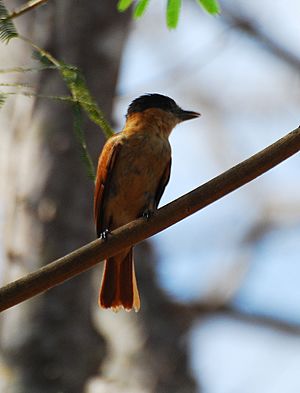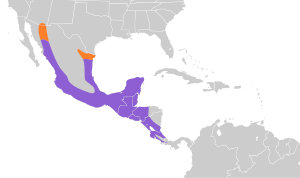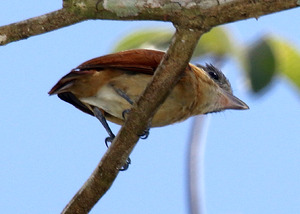Rose-throated becard facts for kids
Quick facts for kids Rose-throated becard |
|
|---|---|
 |
|
| Female | |
| Conservation status | |
| Scientific classification | |
| Genus: |
Pachyramphus
|
| Species: |
aglaiae
|
 |
|
The rose-throated becard (Pachyramphus aglaiae) is a cool medium-sized bird. It's famous for the bright rose color on the male's throat! This bird belongs to a family called Tityridae. For a long time, scientists weren't sure which bird family it belonged to. But new evidence shows it's best placed in the Tityridae family. This bird was named to honor a person named Aglaé Brelay.
Contents
Where They Live
Rose-throated becards like to live near rivers and streams. They also enjoy pine-oak forests and evergreen forests. You can find them breeding from the very south of Arizona and Texas in the United States all the way down to western Panama.
In the U.S., they don't breed everywhere, and it's not always consistent. But in Mexico, they breed much more regularly. Most of these birds stay in one place all year. However, the ones living in the United States usually fly south for the winter.
What They Look Like
The most special thing about the adult male rose-throated becard is its bright rose-colored throat. It looks like a colorful bib! Males are mostly gray. Their upper body is a darker gray, and their belly is a lighter gray. They also have a cool black cap on their head.
Female becards are mostly brown. Their upper body is a rusty brown, and their belly is a pale, creamy color. Their head has a dark gray cap, but it's not as striking as the male's black one. When they call, it sounds like a sad "seeeeuuuwww."
Behaviour
Reproduction
Rose-throated becards usually breed from May to July. If they live in higher places, their breeding season might start a bit later. They build a special nest that looks like a dome. This nest hangs down from a high tree branch.
Females lay between three and six eggs. These eggs can be many different colors! They might be off-white, light purple, olive, or even pinkish. The eggs also have swirly or spotted marks, especially on the larger end.
What They Eat
This bird mainly eats insects. It often picks insects right off plants, which is called gleaning. Sometimes, it will even catch insects while flying! Besides insects, rose-throated becards also enjoy eating berries and seeds.
How They're Doing
Rose-throated becards are quite common where they live. Because of this, they are considered a species of "least concern." This means they are not currently in danger of disappearing. We don't know the exact number of birds in their total population. However, their numbers are going down in some areas, especially at the edges of their range. This is often due to human activities.
See also
 In Spanish: Anambé degollado para niños
In Spanish: Anambé degollado para niños



